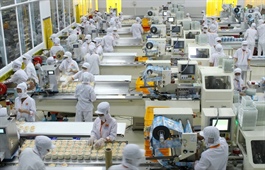Room remains for Vietnamese processed fruit and veggie exports
Room remains for Vietnamese processed fruit and veggie exports
Processed fruits and vegetables will continue to enjoy strong growth potential thanks to their convenience and long preservation time, the Viet Nam Industry and Trade Information Centre has forecast.

Between 2016 and 2020, Viet Nam's processed fruit and vegetable exports grew by double digits annually. In 2019, exports surged by 41.2 per cent year-on-year, before slowing to a still respectable 11.1 per cent in 2020.
Amid the prolonged COVID-19 pandemic, processed fruit and vegetable exports earned US$653.5 million over the past nine months, up 16 per cent year-on-year.
The key export markets for Vietnamese processed fruit and vegetables are China, Japan, South Korea, Australia, Russia and the US. Viet Nam's exports to China grew by 24.8 per cent over the same period in 2020.
The centre forecasts that the COVID-19 pandemic will not negatively affect the global processed fruit and vegetable industry. On the contrary, the supply of processed fruit and vegetables has increased, while the export of fresh or frozen products has fallen, causing a shift among producers.
General Secretary of the Viet Nam Fruit and Vegetable Association Dang Phuc Nguyen agreed. He told Viet Nam News that the country's exports of processed fruits and vegetables have performed positively in the past two years, despite the pandemic.
Nguyen explained that the pandemic has broken transport supply chains, making shipping costs higher due to the limited number of operational ships and aircraft. At the same time, a major maritime incident in the Suez Canal - the gateway for the movement of goods between Europe and Asia - has extended the shipping time of fresh fruits and vegetables.
"The longer shipping process can make fresh fruits and vegetables damaged," Nguyen told Viet Nam News, adding that in this context, fresh fruits and vegetables that cannot be exported will be provided to local processing factories.
This abundant source of raw materials at cheaper prices has helped processing factories to speed up their production capacities for exports, Nguyen said.
He added shelf life and e-commerce are responsible for promoting the consumption of processed fruit and vegetables in imported countries where transportation has also encountered difficulties due to social distancing measures.
Thanks to surging demand and the efforts of local processing factories to expand their production, processed fruits and vegetables currently account for 25-30 per cent of the total national export turnover of fruits and vegetables, compared to 10 per cent in the pre-pandemic period, Nguyen said.
However, the fruit and vegetable processing industry continues to face many shortcomings and limitations.
One issue is Vietnamese products are currently exported under different brand names, which Nguyen attributes to a lack of strong brands at a national level, as well as an insufficient understanding of the tastes of customers and a failure to establish supply chains in overseas markets.
The processing industry only meets 8-10 per cent of the annual fruit and vegetable output. Consumption is still in the form of fresh or preliminary preservation, with post-harvest losses remaining too high at approximately 20 per cent. Thus, there remains room for Vietnamese enterprises to invest in developing processing technology and promoting exports when consumer demand in the world market increases, the Ministry of Industry and Trade (MoIT) said.
Large scale production and exhibitions
To better advertise Vietnamese processed fruits and vegetables to important markets such as the EU, Australia and China, Nguyen called for more investment from the State and relevant ministries and sectors, as well as greater efforts from enterprises.
"Top priority should be given to organising trade fairs and exhibitions to introduce Vietnamese processed fruits and vegetables to customers in imported markets.
"We can learn from Thailand, which held large-scale fruit and vegetable exhibitions in Bejing and Shanghai. During these events, witnessed by the State leaders, visitors could taste Thai durian for free. That is a good way to advertise the image and quality of products to customers," Nguyen told Viet Nam News.
Viet Nam expects to gain $8-10 billion from shipping fruits and vegetables abroad, with revenue from processed products accounting for at least 30 per cent of the total by 2030.
To this end, Viet Nam hopes to attract investments in 50-60 fruit and vegetable processing establishments, building several modern groups and enterprises with strong competitive capacity under a project recently approved by the Prime Minister.
The country needs to also invest heavily to improve processing ability, giving priority to processing key fruits and vegetables which have high values, setting up material zones, and developing markets for the products.
The project stresses the necessity of building processing and packaging facilities, storage warehouses and installing suitable equipment to reduce post-harvest losses.
All production facilities are expected to be well equipped by 2030.
Along with encouraging businesses to invest in food irradiation centres to ensure that products meet international standards, the country must also promote diversification among processed products.
Additionally, it is necessary to establish specialised fruit and vegetable cultivating areas that can provide five-six million tonnes of high-quality raw materials for processing by 2030.
Building links between processing localities and regions with sufficient capital, science, technology and marketing capabilities will also be targeted.
Meanwhile, attention will also be paid to strengthening the capacity of market research and forecasting, as well as updating information on trade policies of countries and markets.
According to the MoIT, the country is now home to 7,500 fruit and vegetable processing and preservation establishments and roughly 150 processing factories that feature modern technology lines.
























